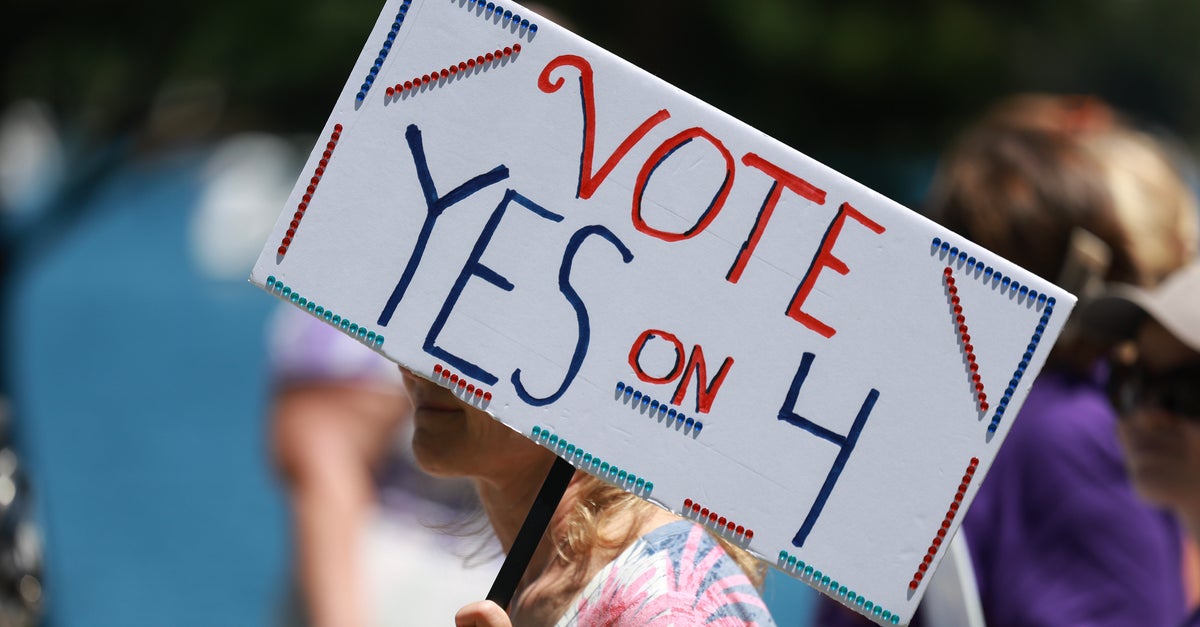The advocates behind Florida’s pro-choice Amendment 4 cleared a huge hurdle in April when the notoriously conservative state Supreme Court approved the measure for the November ballot. Many were relieved at the time — believing that the biggest obstacle was behind them — but after this week, it’s clear they’re not out of the woods just yet.
A Florida administrative committee decided earlier this week on a financial impact statement that must appear alongside Amendment 4 on ballots. Over the course of three meetings, including a 12-hour debate on Monday, the Florida Financial Impact Estimating Conference crafted a statement riddled with misinformation that will be printed next to the amendment seeking to restore abortion access until around 24 weeks in the state.
The supposedly nonpartisan FIEC crafts fiscal statements to appear next to any citizen-led measure that makes it on the ballot. The panel is usually made up of a Florida House staffer, a Florida Senate staffer, a representative from the governor’s office and the state’s chief economist. But state House Speaker Paul Renner (R) replaced the House staffer with an economist from the Heritage Foundation, the ultra-conservative think tank behind Project 2025.
Abortion rights advocates who fought for the ballot measure believe the FIEC statement includes inaccurate information that was written to intentionally mislead voters. Read the statement in full below:
“The proposed amendment would result in significantly more abortions and fewer live births per year in Florida. The increase in abortions could be even greater if the amendment invalidates laws requiring parental consent before minors undergo abortions and those ensuring only licensed physicians perform abortions. There is also uncertainty about whether the amendment will require the state to subsidize abortions with public funds. Litigation to resolve those and other uncertainties will result in additional costs to the state government and state courts that will negatively impact the state budget. An increase in abortions may negatively affect the growth of state and local revenues over time. Because the fiscal impact of increased abortions on state and local revenues and costs cannot be estimated with precision, the total impact of the proposed amendment is indeterminate.”
The statement speculates on the costs created by possible future litigation, even though doing so directly conflicts with standards set by the Florida Supreme Court. The statement also inaccurately says that Florida may have to “subsidize abortions with public funds” and that an increase in abortions “may negatively affect the growth of state and local revenues.”
The move is “a dirty trick to mislead voters,” Lauren Brenzel, the campaign director for Floridians Protecting Freedom, the coalition behind the state’s pro-choice amendment, said in a press statement.
“The fact that you would have to appoint political operatives to what’s supposed to be a bureaucratic commission shows how afraid you are of having the people’s voices heard,” Brenzel told HuffPost later by phone. “This is about the dismantling of what’s supposed to be a non-biased process for political aims.”
Amy Baker, the FIEC’s chief economist who has worked for the state for decades, was the lone dissenter. Several times during Monday’s meeting, Baker voiced her concerns that the panel had strayed from its nonpartisan mission.
State Rep. Anna Eskamani (D) pointed out that Baker has only dissented on a fiscal statement once or twice before. “It means that the chief economist wasn’t comfortable supporting this language,” Eskamani, who worked at Planned Parenthood for six years before being elected to the Florida House, told HuffPost. “If she’s not gonna put her stamp of approval on this, then it speaks to the intention of this language.”
Amendment 4 needs to get 60% of approval from voters for it to pass and restore abortion access until fetal viability. Gov. Ron DeSantis (R) and the state’s Republican supermajority passed a 15-week abortion ban after Roe v. Wade fell in the summer of 2022. Despite the restriction, the Sunshine State was still a critical safe haven for abortion access in the South where nearly all surrounding states have near-total abortion bans. In May, a six-week abortion ban went into effect, crippling access in Florida and the majority of the Southeast.
Abortion rights amendments have been extremely successful in both red and blue states since the fall of Roe in 2022. In response, anti-abortion advocates and lawmakers across the country have used normal administrative steps like Florida’s fiscal impact statement to confuse voters about pro-choice amendments.
Last year, Ohio Republicans crafted and approved a misleading summary statement for the state’s pro-choice amendment. Similar to Florida’s fiscal statement, Ohio’s summary did not change the meaning or intent of the constitutional amendment but was created by anti-choice lawmakers to confuse voters. The Ohio abortion rights amendment passed last November, restoring access until fetal viability.
“This process has never been weaponized like this before,” Brenzel said. “I think it shows how scared our opposition is of this initiative.”







